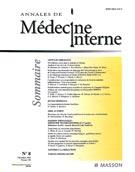Vasculopathie livédoïde (ou atrophie blanche) associée à la présence d'anticorps anti-cardiolipines - 16/02/08
Anne Grasland [1],
Béatrice Crickx [2],
Michel Blanc [3],
Jacques Pouchot [1],
Philippe Vinceneux [1]
Voir les affiliationsVasculopathie livédoïde (ou atrophie blanche) associée à la présence d'anticorps anti-cardiolipines. |
Introduction . - Les vasculopathies livédoïdes sont des affections rares du sujet jeune qui méritent d'être différenciées, dès l'examen clinique, des vascularites cutanées.
Observation . - Un homme de 27 ans présentait une éruption, prédominant aux pieds, faite de placards violacés, prenant un aspect livédoïde, ulcérés aux malléoles, et associés à des zones d'atrophie blanche. La biopsie cutanée révélait l'existence d'une thrombose capillaire dermique, sans leucocytoclasie, permettant de retenir le diagnostic de vasculopathie livédoïde. La recherche d'anticorps anti-cardiolipines était positive. Un traitement anticoagulant par anti-vitamine K était instauré, permettant la cicatrisation des ulcères et l'absence de récidive avec un recul de 7 mois.
Discussion . - Les vasculopathies livédoïdes sont des affections caractérisées par l'existence de lésions, prédominant aux membres inférieurs, douloureuses, purpuriques, souvent livédoïdes, parfois ulcérées, évoluant vers des cicatrices atrophiques blanc porcelaine. L'histologie montre des phénomènes thrombotiques. Les vasculopathies livédoïdes sont généralement isolées. Des associations à la présence d'anticorps anti-cardiolipines ont été rapportées, conduisant à discuter le lien de cette entité avec le syndrome des antiphospholipides.
Livedoid vasculopathy (atrophie blanche) associated with anticardiolipin antibodies. |
Background . - Livedoid vasculopathy is an uncommon condition that affects young patients. It must be clinically distinguished from cutaneous vasculitis.
Case report . - A 27-year-old man presented pain and skin eruptions involving the lower limbs, hands and trunk. The skin eruption predominated on the feet with purpuric lesions producing a livedoid pattern, ulcerations on both ankles and white atrophic scars on the dorsum of the feet. Skin biopsy showed dermic vessel thrombosis without leukocytoclasia. These features favored livedoid vasculopathy rather than vasculitis. Anticardiolipin antibodies were positive. The patient was started on antithrombotic therapy. The skin ulcerations regressed and no recurrence has been observed at 7-months follow-up.
Discussion . - Livedoid vasculopathy is characterized by painful purpuric lesions that generally occur on the lower limbs, and frequently ulcerate and heal leaving porcelain white atrophic scars (atrophic blanche). The histology evidences a thrombotic process. Livedoid vasculopathy is normally described as occurring as a sole entity, however thera have been reports of an association with anticardiolipin antibodies. This suggest a possible link with antiphosphlipid syndrome.
Mots clés : Vasculopathie livédoïde. , Atrophie blanche. , Anticorps anti-cardiolipines. , Syndrome des antiphospholipides.
Keywords:
Livedoid vasculopathy.
,
Anticardiolipin antibodies.
,
Atrophie blanche.
,
Antiphosphlipid syndrome.
Plan
© 2000 Elsevier Masson SAS. Tous droits réservés.
Vol 151 - N° 5
P. 408-410 - octobre 2000 Retour au numéroBienvenue sur EM-consulte, la référence des professionnels de santé.

